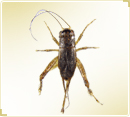What you need in advance

Use a water bottle made of plastic or a big cup with dry sand spread on the bottom of the cup. The thickness of the sand should be around 1 ㎝. Also, put many layers of folded and wrinkled thick paper or filter paper inside the container. This can provide a hideout for the cricket, and can widen the area.
You can raise up to 50 large species such as Teleogryllus emma and 100 small species such as Dianemobius nigrofasciatus and Gryllodes supplicans in a 10-liter container if you provide enough places to hide.
Cautions
The sand should always be dry, because it could be prone to mites and mold when the humidity is too high.
Alternatively, you should put water in the container by putting in a bottle filled with water and covered with cotton.
You should pay attention because when there is no water, the crickets will die.
Food and ecology
- 1. It is convenient to use an insect fodder as their food. Alternatively, you can use a combination of sliced rice bran and fish jerky. You should heat it up first to kill mites that appear inside the feed.
- 2. Place the food over the container once in a while, and put cabbage leaves and carrots in sometimes (this differs by species).
- 3. Because crickets are omnivores, they can eat various fruits and vegetables such as apples, pears, cucumbers, and pumpkins, as well as anchovies and fish jerky. They can also eat chips.
- 4. You can use a dish to feed the cricket.
- 5. When raising Dianemobius nigrofasciatus, a small species, it is sufficient to cover the container with a plastic screen (mosquito net), but for Teleogryllus emma, a large species, a lid made of wire net is required because it can tear it and escape.
- 6. In general, containers for raising crickets should be maintained so as to be dry inside, but in the case of Dianemobius nigrofasciatus, it likes humid conditions, so place a wet cloth on the lid or make the sand on the bottom wet to control the humidity. However, high humidity may cause the rotting of food, so it is required to exchange the food frequently.

